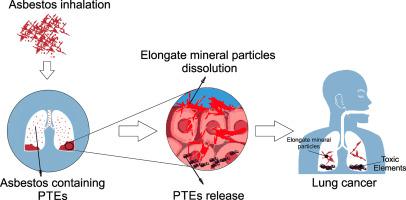当前位置:
X-MOL 学术
›
Chem. Geol.
›
论文详情
Our official English website, www.x-mol.net, welcomes your
feedback! (Note: you will need to create a separate account there.)
Potentially toxic elements (PTEs) associated with asbestos chrysotile, tremolite and actinolite in the Calabria region (Italy)
Chemical Geology ( IF 3.6 ) Pub Date : 2020-12-01 , DOI: 10.1016/j.chemgeo.2020.119896 Andrea Bloise , Claudia Ricchiuti , Rosalda Punturo , Dolores Pereira
Chemical Geology ( IF 3.6 ) Pub Date : 2020-12-01 , DOI: 10.1016/j.chemgeo.2020.119896 Andrea Bloise , Claudia Ricchiuti , Rosalda Punturo , Dolores Pereira

|
Abstract Potentially toxic elements (PTEs) hosted in asbestos elongate mineral particles is one of the factors that determines their toxic/pathogenic effects. This study quantifies and compares these elements in terms of major, minor and trace element concentrations (Si, Mg, Ca, Al, Fe, Mn, Cr, Co, Ni, Cu, Zn, Be, V, As, Rb, Sb, Ba, Pb, Sr) in various types of asbestos using micro X-ray fluorescence (μ-XRF) and inductively coupled plasma mass spectrometry (ICP-MS), in order to understand how they contribute to asbestos-related diseases. Chrysotile, tremolite asbestos and actinolite asbestos extracted from the Gimigliano-Mount Reventino Unit (Calabria Region, Southern Italy) were used for this study. In the minerals analysed, high concentrations of Cr (171 ppm) and Be (2.9 ppm) were found in tremolite asbestos and chrysotile respectively. When calculating the pseudo-total concentrations of trace elements in the samples, the largest amounts were detected in tremolite asbestos, followed by actinolite asbestos and chrysotile. However, since other metals such as Mn and Fe (minor elements) are known to induce toxicity, and considering their input to the overall balance, actinolite contained the largest amount of PTEs and in this case chrysotile proved to be more toxic than tremolite asbestos. Furthermore, the potential leaching of PTEs, released by chrysotile, tremolite and actinolite asbestos-containing rocks, into the soil and water supply is also discussed. Since asbestos elongate mineral particles can be widespread in the environment (i.e. air, rocks, soil, water), it is essential to quantify the toxic elements present in asbestos elongate mineral particles in order to prevent asbestos-related diseases. The knowledge obtained from this study will provide us with a better understanding of asbestos-related lung cancer.
中文翻译:

与卡拉布里亚地区(意大利)的石棉温石棉、透闪石和阳起石有关的潜在有毒元素 (PTE)
摘要 石棉细长矿物颗粒中的潜在有毒元素 (PTE) 是决定其毒性/致病作用的因素之一。本研究根据主要、次要和微量元素浓度(Si、Mg、Ca、Al、Fe、Mn、Cr、Co、Ni、Cu、Zn、Be、V、As、Rb、Sb、使用微 X 射线荧光 (μ-XRF) 和电感耦合等离子体质谱 (ICP-MS) 检测各种类型石棉中的 Ba、Pb、Sr),以了解它们如何导致石棉相关疾病。本研究使用了从 Gimigliano-Mount Reventino Unit(意大利南部卡拉布里亚地区)提取的温石棉、透闪石和阳起石石棉。在所分析的矿物中,透闪石石棉和温石棉中分别含有高浓度的 Cr (171 ppm) 和 Be (2.9 ppm)。在计算样品中微量元素的假总浓度时,透闪石石棉中检出量最大,其次是阳起石石棉和温石棉。然而,由于已知其他金属,如 Mn 和 Fe(微量元素)会引起毒性,考虑到它们对整体平衡的输入,阳起石含有最大量的 PTE,在这种情况下,温石棉被证明比透闪石石棉毒性更大。此外,还讨论了温石棉、透闪石和阳起石含石棉岩石释放的 PTE 可能浸出到土壤和水源中。由于石棉细长的矿物颗粒可以广泛存在于环境中(即空气、岩石、土壤、水),必须量化石棉细长矿物颗粒中存在的有毒元素,以预防与石棉有关的疾病。从这项研究中获得的知识将使我们更好地了解石棉相关的肺癌。
更新日期:2020-12-01
中文翻译:

与卡拉布里亚地区(意大利)的石棉温石棉、透闪石和阳起石有关的潜在有毒元素 (PTE)
摘要 石棉细长矿物颗粒中的潜在有毒元素 (PTE) 是决定其毒性/致病作用的因素之一。本研究根据主要、次要和微量元素浓度(Si、Mg、Ca、Al、Fe、Mn、Cr、Co、Ni、Cu、Zn、Be、V、As、Rb、Sb、使用微 X 射线荧光 (μ-XRF) 和电感耦合等离子体质谱 (ICP-MS) 检测各种类型石棉中的 Ba、Pb、Sr),以了解它们如何导致石棉相关疾病。本研究使用了从 Gimigliano-Mount Reventino Unit(意大利南部卡拉布里亚地区)提取的温石棉、透闪石和阳起石石棉。在所分析的矿物中,透闪石石棉和温石棉中分别含有高浓度的 Cr (171 ppm) 和 Be (2.9 ppm)。在计算样品中微量元素的假总浓度时,透闪石石棉中检出量最大,其次是阳起石石棉和温石棉。然而,由于已知其他金属,如 Mn 和 Fe(微量元素)会引起毒性,考虑到它们对整体平衡的输入,阳起石含有最大量的 PTE,在这种情况下,温石棉被证明比透闪石石棉毒性更大。此外,还讨论了温石棉、透闪石和阳起石含石棉岩石释放的 PTE 可能浸出到土壤和水源中。由于石棉细长的矿物颗粒可以广泛存在于环境中(即空气、岩石、土壤、水),必须量化石棉细长矿物颗粒中存在的有毒元素,以预防与石棉有关的疾病。从这项研究中获得的知识将使我们更好地了解石棉相关的肺癌。











































 京公网安备 11010802027423号
京公网安备 11010802027423号